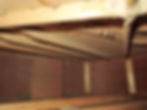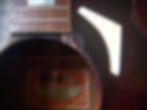'70's Gibson acoustics are not considered top of the class for a number of reasons.Demand had soared and Gibson had introduced changes to improve the instruments durability to cut down on warranty repairs which were still being done at the factory,changes which were widely believed to have cost the guitars tone and volume.
There were cosmetic changes too,again to cut cost by speeding production.....finishes were sprayed over the scratchplate and rosette,but this was not scraped afterwards anymore so was often more than half hidden on sunbursts.Inlays were simplified even the Hummingbird going to plain blocks.
On a positive side Gibson still had stocks of well matured old Honduras mahogany and the Spruce for tops remained of excellent quality as was the East Indian rosewood for bridge and fingerboard which by the start of the '70's had almost entirely replaced Brazilian.Necks became three piece with a volute,mahogany on the more expensive models,maple stained more like walnut on the others...it often produces a blotchy,mottled effect,not an aesthetic triumph for Gibson.With most of these guitars now approaching the 50 yr mark this quality of timber,esp if the instrument has been well used,has produced some nice sounding examples.
But the biggest changes were less obvious,worked into the construction and design.The most notorious of these was the introduction of "Double X Bracing" to reduce the incidence of top bellying and simplify construction.

In some ways it was not all bad....the X braced models often show a neater finish than older guitars and the second X usually uses smaller braces showing there was an awareness of the effect on tone and volume.

Where the big sonic change happened was probably the bridgeplate on the underneath more than the bracing.Made of thick ply and glued neatly but rigidly into the diamond formed by the double X it contributed significantly to a top that was more rigid than earlier models.Not always a bad thing....they amplify well and record well and hold their sound together when pushed.This may help explain why Paul Weller's favourite stage and studio acoustic is a '70's J45 rather than a 50's or suchlike.
But this stable but stiffer top contributed to other structural issues when combined with the underset necks that were adopted at the same time...generally acoustic guitars feature a mild upset in the neck,whereby the fingerboard will be slightly higher at the body end than the nut end...look at a Les Paul to see an exaggerated version of this adopted from archtop acoustics.
The 70's Gibson acoustics had their necks pitched much more level,more like a Fender in comparison..thus rather than up and back the string tension pulls the neck straight back and the stiff rear top,rather than bellying,frequently causes these to sink at the soundhole more than most acoustics.The only slight positive is that the underset was partially compensated for by using low bridges,frequently lowered further over the years,which partially balance out the bulk of the bridgeplate...though susceptible to splitting!
Sadly,it doesn't end here as an older problem,common to both Gibson and Martin, can combine with the others to produce a sometimes literal implosion.Both companies had for years used celluloid,frequently tortoiseshell pattern,for scratchplates.The underneath was brushed with acetone melting the surface and effectively welding it into the bare spruce of the top.
This was one of the first plastics,dating back to the 1850's. By 1869 it was awesomely known as Xylonite but sadly was boringly registered as Celluloid in 1870. It has a number of disadvantages,amongst them spontaneous combustion,but the one that concerns us most is shrinkage.Once welded to the guitar top it shrank to varying degrees and frequently causes cracks in the thin spruce of the top,usually alongside the neck or between the soundhole and bridge.

Worst case scenario is cracks develop both sides and the fingerboards and neckblock all shift backwards .
In this case the block was holding(though the crack ran all the ways to the front) and all the braces were secure.A neck reset was not needed and the aim was to close the crack and level the top around the soundhole.
Firstly the mess of putty had to be cleaned up to see how the spruce was underneath.This is how it looked.I decided on a large,wide cleat,shaped to fit tightly against the cross brace and the flat "lollipop"brace which runs at a slight angle lengthways.this was bevelled where it follows the soundhole curve to make it less visible when in place.
In this case even though I have some very tight grained soundboard spruce available also decide to use a stronger species than for regular small cleats as it also had to hold the top with attached scratchplate down so this is Maritime Pine,cut from the centre of an old floorboard and thinned down.I also cut a sliver of spruce and shaped it to fit the gap in the top as a filler piece. With the top still secure to the large brace below it would have been impossible to force it together together.

Once I was satisfied the cleat was a snug fit it and the filler piece were clamped and glued with hide glue.Left for over 24 hrs I was relieved to find it level and strongly held.The slowest and most painstaking part was left,trying to produce a finish touch up that matched the worn original.


The aged finish took about a week of very small steps well spread out to allow drying. It blends in well and the only real sign of what was a fairly substantial crack is the cleat underneath.
This SJ is a real warrior and also needed its bridge reglued,a platemate made and fitted,new bone nut and saddle and pins.A endpin jack and a sidejack were both removed and the holes plugged with mahogany about the same age as guitar.The end block was then redrilled and reamed to take a white galalith endpin.

The result should be good for another 40yrs plus and is a very comfortable acoustic to play with a rich,sweet tone.The woods are by now well settled and harmonised and with care and consideration this should not need further major work again.

